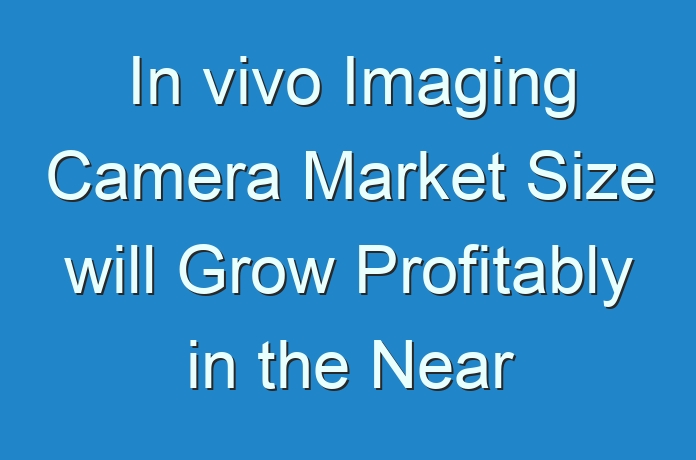
Global In vivo Imaging Camera Market: Introduction
- In-vivo imaging camera is used for non-invasive visualization of living organisms for research or diagnostic purposes. In-vivo imaging system is used in two key areas anatomical/morphological imaging and molecular imaging. In anatomical imaging, no marker is used and visualization is based on the intrinsic properties of the tissues and organs being observed, such as the attenuation of X-rays in the case of computed tomography. Molecular imaging often uses biomarkers labelled with bioluminescence or fluorescence.
Request Brochure –
https://www.transparencymarketresearch.com/sample/sample.php?flag=B&rep_id=80009
- The five main categories of in vivo imaging technology are: computed tomography (CT), positron emission tomography (PET), magnetic resonance imaging (MRI), optical techniques and ultrasound scanning. Optical techniques employ the camera concept for in-vivo Imaging.
- Technological development has helped overcome classical issues faced with histology. Improved detection of deep tissue biology, in the context of structure and morphology of tissues is often needed, making 3-dimensional (3D) in vivo fluorescence imaging increasingly important in the field of biomedical research. An in vivo imaging camera system combines 2D optical and 3D optical tomography in one platform. The system uses leading optical technology for preclinical imaging research and development, ideal for non-invasive longitudinal monitoring of disease progression, cell trafficking, and gene expression patterns in living animals.
Request COVID Analysis on In vivo Imaging Camera Market –
https://www.transparencymarketresearch.com/sample/sample.php?flag=covid19&rep_id=80009
Key Drivers, Restraints, and Opportunities of Global In-vivo Imaging Camera market
- In-vivo camera imaging has been in great demand especially in the research & development laboratories of different sectors including biology, medical and chemical. Traditional experiment approach requires a large number of killing of animals at different times to analyse biological processes over time. In vivo camera imaging requires just a few specimens are required as the progression can be studied without sacrificing the animal. Moreover, the accuracy of in-vivo camera imaging has been a major factor driving the global in-vivo imaging camera market.
- A few limitations to the technique also need to be considered. In-vivo imaging systems can have limited tissue penetration (<1 cm) and is prone to attenuation with increased tissue depth. Elastic scattering of light is projected to occur in almost all tissues, resulting in strong attenuation as well as loss of directionality and therefore limited ability to form high-resolution images. Furthermore, research & development is estimated to help overcome this concern.
- Increased clinical application and replacement of traditional imaging systems are projected to offer significant opportunities for the global in-vivo imaging camera market. Rapid advances in high-resolution in vivo imaging camera technologies are projected to offer a unique opportunity to study biological processes of living organisms in real-time on a molecular level.
Request Customization on In vivo Imaging Camera Report –
https://www.transparencymarketresearch.com/sample/sample.php?flag=CR&rep_id=80009
North America to Capture Major Share of Global In-vivo Imaging Camera market
- North America is a prominent contributor in the healthcare research & development field, which has boosted the demand for in-vivo imaging camera. The device has become an indispensable tool in basic sciences, in preclinical research, and in modern drug development. The number of animals involved in scientific investigation can be substantially reduced by using imaging techniques, which is in full compliance with the ethical endeavours for 3R (reduction, refinement, replacement) followed in the region. North America accounts for a major share of the global In-vivo imaging camera market.
- Europe holds the second-largest share of the global In-vivo imaging camera market. The region is a hub of prominent countries in the healthcare market, where the demand for in vivo imaging camera system is considerably for clinical purposes. Moreover, government policies that promote research & development in the healthcare sector has also fuelled the In-vivo imaging camera market in the region.
Pre Book In vivo Imaging Camera Report –
https://www.transparencymarketresearch.com/checkout.php?rep_id=80009<ype=S
Key Players Operating in Global In-vivo Imaging Camera market
The smart home healthcare market is highly fragmented, owing to the presence of various key players. A large number of manufacturers hold a major share in their respective regions. Major players operating in the global in-vivo imaging camera market are:
- Vieworks
- Olympus
- Leica
- ZEISS Internationa
- Becker and Hickl
- HORIBA
- PicoQuant
- Bruker
- Nikon
- Lambert
- Jenlab
- LI-COR Biosciences
Trending Reports of Transparency Market Research –
Photopheresis Products Market –
Medical Waste Containers Market –
About Us
Transparency Market Research is a global market intelligence company providing global business information reports and services. Our exclusive blend of quantitative forecasting and trends analysis provides forward-looking insight for several decision makers. Our experienced team of analysts, researchers, and consultants uses proprietary data sources and various tools and techniques to gather and analyze information.
Our data repository is continuously updated and revised by a team of research experts so that it always reflects latest trends and information. With a broad research and analysis capability, Transparency Market Research employs rigorous primary and secondary research techniques in developing distinctive data sets and research material for business reports.
Contact
Transparency Market Research,
90 State Street, Suite 700,
Albany, NY 12207
Tel: +1-518-618-1030
USA – Canada Toll Free: 866-552-3453
Email: sales@transparencymarketresearch.com
Website: https://www.transparencymarketresearch.com





